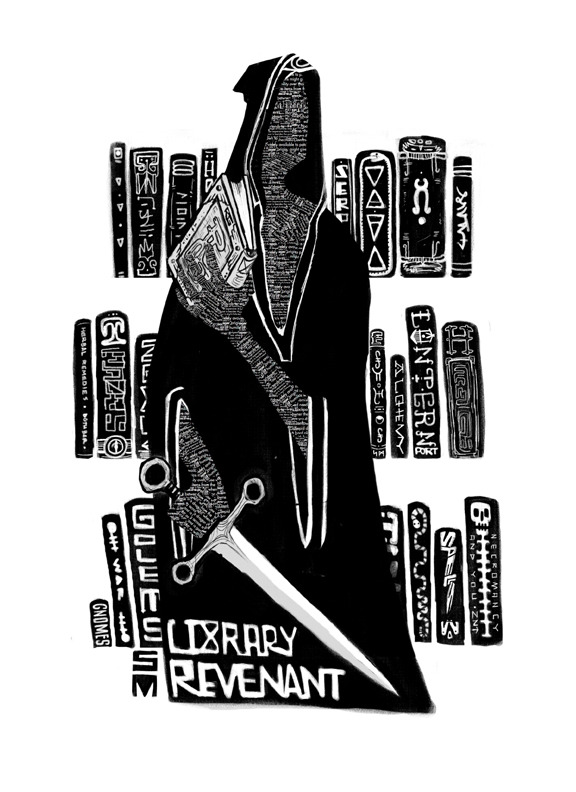On Magic
No one learns magic to become kindly and wise, or to save the kingdom. As nobles rely on land, treasures, retainers, and swords for their power, wizards rely on spells and secret knowledge, which they guard just as fiercely. Hence, there are no colleges of magic or schools for sorcery. Wizards hoard their knowledge, and choose their apprentices carefully, never revealing the whole of their learning.Magic can do terrible and strange things, certainly, but it cannot alone rule the peasants, reap the harvest, or lead men into battle. For this reason, magic does not claim kingdoms or domains, although the aristocracy often seek out the wise for counsel and aid.
Although there are almost as many traditions of magic as magicians, certain principles are constant:
- Nothing will come of nothing. A wizard cannot create something from nothing, or effect change without consequences. Hence, a wizard cannot conjure flames out of thin air, although magic can persuade a smoldering ember to spark and leap and burn.
- Sympathy generates effects; follow the nature of things. Acquiring a personal item makes it easier to follow or charm someone. Dropping a grain of sand into a lock makes it impossible to open, touching a flint to a blade can make it razor sharp.
- Magic is not orderly. Magic disturbs nature, and hence a spell cannot be recited by rote and expected to work in the same way every time. The effects of a spell cannot be calculated exactly, and all spells must be part invention and circumstance. By the same token, all charms are mutable, and no magic cannot be undone, although the right way may be obscure and surpassingly difficult.
- Terrible powers have terrible consequences. The more powerful the magic, the sharper the peril. A spell of bear-form may lead the caster to becomes solitary and bearish. A spell for viewing from afar may make the caster obsessed with spying. The Fell Lords know well the price of the hunger for power.
- There is always another way: wizard's deceive nature, and even where one spell fails, another trick may suffice.
- No spell is perfect or entire.
Using Magic in Your Game
First, a character must have the second-sight (which means they can always see ghosts and the fey, by the way, and are not easily fooled by appearances) and they must have some schooling in practical magic. It helps to have been an apprentice, or belong to a tradition (witchcraft, sorcery, and so on).Second, each magician should have at least one study: an area of magic that they have devoted care and attention to. Studies are individual, like skills. Smoke and fire could be one area of study, or luck and chance. A witch might study curses, or the ways of the deep woods (the language of beasts and plants included).
There are, of course, far too many spells to enumerate or list, but when the time comes to cast a spell, an appropriate study always makes bringing a spell to mind more likely.
In terms of working magic, spells fall within at least four categories: tinkering, tampering, bending, breaking. All of these categories show how hard a magic is to accomplish:
- Tinkering: anything that could seem like exceptional skill or luck: the knot that won't slip, the herb that heals and just happens to be at hand, the object that disappears as though by sleight.
- Tampering: spells that manipulate probability or temporarily subvert the natural order. The lock that springs open, or the buckle that slips in combat. Easier if the magician can leverage natural conditions (the icy ground becomes deadly slippery, a horse shies, the door jams), luck (the dagger that is not found in a search), or unusual facility (throwing the voice to trick pursuers).
- Bending: Distorting or temporarily suspending the laws of nature. Drawing a flame out of dry wood, assuming the looks and manner of another individual, lulling a target to sleep or friendship, raising a breeze or a mist, soliciting the opinion of a tree.
- Breaking: Magic that sets aside nature; things impossible by all other means. Speaking to the dead, causing an object to take flight, stepping into another mind or dream, changing form.
In play, magic should be like any other character action: the player should specify the magic and the effect the character wants to achieve. The GM should decide on the difficulty (from tinkering, which will be of medium difficulty, to breaking, the most difficult) and rule if the spell is possible, based on the character's intentions and study. Bending or breaking spells usually require some study.
When the spell is cast, it takes effect, and the results are described. There are no magic points to consider, but there are always the consequences of magic. In Fighting Fantasy, for example, a failed spell might require a Test for Luck to avoid some dangerous fallout.
